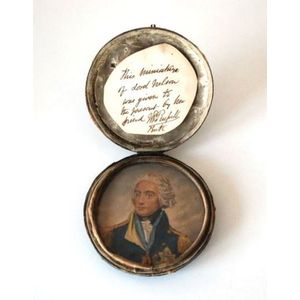Georgian Polychrome Miniature Ring in Yellow Gold
You must be a subscriber, and be logged in to view price and dealer details.
Subscribe Now to view actual auction price for this item
When you subscribe, you have the option of setting the currency in which to display prices to $Au, $US, $NZ or Stg.
- Polychrome - Made or finished in many colours. For furniture, it is used to indicated a painted finish.
- Georgian - As an English stylistic period, Georgian is usually taken to cover the period from George I (1714) to the Regency of Prince George (1811-20), although the period from 1800 to 1830 is sometimes designated as the Regency period. During the Georgian period the great English cabinetmakers and designers such as Chippendale, Hepplewhite, Adam Sheraton etc., were all active.
Therefore there isn't a single 'Georgian style' as such and to say something is 'Georgian', usually means it was made between 1714 and 1830. This assumes we discount George V and George VI, both being from the 20th century.
The styles popular at the time of each reign were:
George I (1714-1727) saw out the last years of the Baroque period.
George II (1727-1760) reigned during the Rococo period.
George III (1760-1820) saw the last gasp of the Rococo, all of the early Neo-Classic 'Adam style' and most of the later neo-Classic 'Regency style'.
George IV (Prince Regent 1820-1830)encompassed the last of the 'Regency' style.
William IV's reign (1830-1837) was something of a no man's land (stylistically) and he wasn't a 'George' anyway. He covered the last glimmerings of 'Regency' and the start of the 'Victorian' style. - Circa - A Latin term meaning 'about', often used in the antique trade to give an approximate date for the piece, usually considered to be five years on either side of the circa year. Thus, circa 1900 means the piece was made about 1900, probably between 1895 and 1905. The expression is sometimes abbreviated to c.1900.
This item has been included into following indexes:
Visually similar items

England: silver medal for the Royal Society for the Encouragement of Arts, Manufactures and Commerce. The obverse features the conjoined heads of Mercury, in a cap, and Pallas Athene, in a helmet. The legend: 'Arts and Commerce Promoted'. The reverse featu

A Victorian brooch, round shaped mourning brooch with interior filled, metal pin, in 14ct yellow gold. Diameter 3 cm. Weight 11g.

A portrait miniature, Lord Nelson, to commemorate his victory at the Battle of the Nile, 2nd August 1798, painted on card, in circular blue leather lidded case

A French .950 silver tray, 20th century, bearing a hexagonal stamp with mercury profile, a plain circular tray with a convex cavetto, decorated with an applied ribbon and floral border; hexagonal mark underside, silver weight 306gr, diameter 19.5 cm
